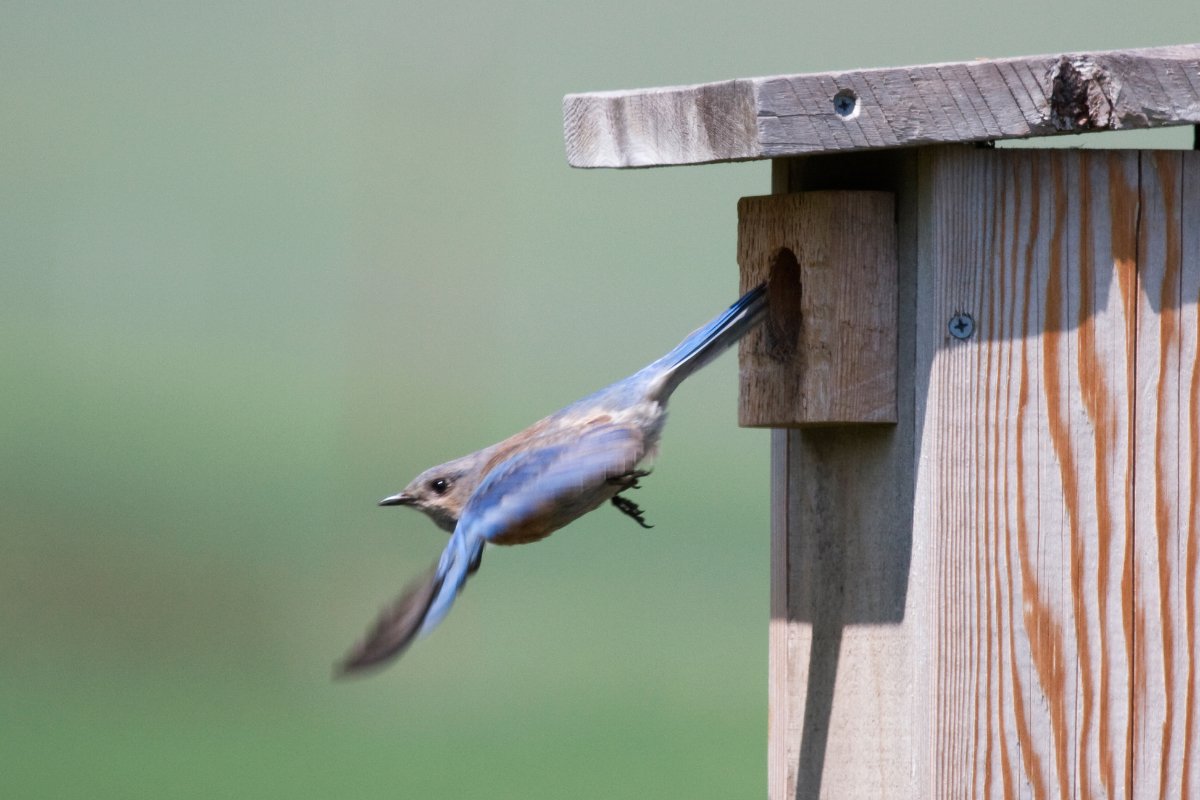The Wild Farm Alliance is working with farmers across California and beyond to help farmers take advantage of birds as natural pest control.

The Wild Farm Alliance is working with farmers across California and beyond to help farmers take advantage of birds as natural pest control.
February 27, 2023

A Western Bluebird leaving its nestbox on a farm. (Photo credit: Kevin Cole)
A version of this interview originally appeared in The Deep Dish, our award-winning, members-only newsletter. Become a member today and get the next issue in your inbox.
For more than two decades, Wild Farm Alliance (WFA) has provided just that—an alliance—between farmers and wildlife advocates. Based in California, the group is focused on finding common ground between two groups that have often been at odds in an effort to address the biodiversity crisis while helping farms benefit from adding more wildlife to their operations.
Executive director Jo Ann Baumgartner has been with WFA since 2001, and she’s a passionate advocate for what she and WFA call “bringing nature back to the farm.” Baumgartner spoke with us about the one of the group’s core efforts in recent years: building awareness about the value of birds on farms.
This interview has been edited for length and clarity.
Why focus on birds?
We have a goal of [adding] a million nest boxes and perches on 10 percent of farmland in the U.S. Our audience is mainly growers, and so we want to show them where they can see the benefits, but we also want to educate them about the need for nature to be supported. There are so many species in decline and so many ways that farmers can help, because agriculture comprises almost 60 percent of the landscape [in the U.S.] when you count all the grazing lands, and it’s a huge footprint. With farmers’ help, we can do a lot to reduce the biodiversity crisis, and they can benefit from it.
Some readers may be more familiar with how birds can eat farmers’ crops than the ways they can interact with farmlands positively. How are you working to shift the narrative?
Well, a few years ago, we published this booklet called Supporting Beneficial Birds and Managing Best Birds [that detailed ways farmers can reduce their pest-control costs by hosting more songbirds during their nesting season]. And before that, most of the growers I talked to—even growers that were finding lots of creative ways to support biodiversity—the first thing they wanted to tell me was about how birds had wrecked something on their farm. But I don’t hear that so much anymore. There are a lot more people we need to reach, but growers are starting to learn that there are so many beneficial things that birds do related to pest control, and different kinds of birds offer different kinds of pest control.
It’s just like some people think all insects are bad. But really there are beneficial insects, and there are insects that can be harmful, but most of them are good. And with birds, there a few that are bad for farms some of the time.
It seems like both need to be kept in balance, and when they get out of balance is when it’s a real problem for farms?
Yes! We’ve collected around 120 avian pest-control studies and broken it down into different crops in different temperate climates; 90 percent of the studies showed that birds were important. And, not all researchers did the exact same study. Some of them were asking, “Is habitat nearby important?” Yes, it is: The more habitat you have, the more pest control benefits you get. And some asked, “Is it important to have nesting boxes?” And yes—you get more pest control benefits with nesting boxes.
Five percent of the studies showed that while birds were helpful, they also were harmful. So, for instance, in the spring, blackbirds eat all kinds of [harmful] insects when they’re feeding. But later in the year, they may potentially harm, say, a sunflower crop because they’re flocking birds. It’s really the big flocks of birds that can be a problem and there are very few species that do that.
There’s some research that looked at monoculture strawberries and then strawberries that were growing in more diverse farmscapes, and the researchers found that a diversity [of crops] supported a diverse community of birds, and that’s when you have more pest control coming from that community and less damage or less food-safety issues.
And the food safety issues really are coming from birds that are associated with concentrated animal feeding operations (CAFOs), where we’ve created a mess and they get into it. Birds go looking for spilt grain and get into the manure and then it’s not good for them to come onto your farm.
When we talk about this to growers, they inevitably tell me stories about how they’ve seen birds help. For example, we just had an event in Livingston, California, in the heart of the Central Valley ag region, where we had helped an almond grower put in a hedgerow and he told me he has seen crows clean off the mummy nuts [almonds that stay on the trees after they’re shaken, and often can carry insects and diseases that impact the following year’s crop].
Growers are paying attention, and I’ve heard lots of stories like that. Farmers, especially the ones who are already managing for diversity, are really curious about birds, and some of them are putting in lots of nest boxes. There’s a grower at Spring Mountain Vineyards in Napa who has 800 nest boxes in their vineyards. Most growers don’t do that, but a lot of vineyards are putting in nest boxes, because there are some really great studies about how they increase bluebird presence in vineyards tenfold.
When the researcher put out experimental prey, bluebirds ate almost three times as many insects near nest boxes versus far away from the boxes. And it’s not just bluebirds that use these boxes, there are other really good insectivorous birds that use them—like tree swallows, which are aerial foragers, meaning they’re cruising around in the air and catching moths, flies, and flying insects. There’s chickadees, titmice, and ash-throated flycatchers, violet-green swallows, and a couple of different kinds of wrens and nuthatches.
I’ve read that the drought has greatly impacted migration, as many of the wetlands and bodies of water where migrating birds used to stop and refuel have been drying up in recent years. Are some birds looking to farms to fill that gap?
I’ve heard that, too, and those birds aren’t really helping with pest control on farms. Some farmers are working with conservationists to flood some of their lands when they can, but that tends to attract waterfowl and shorebirds and the raptors that eat them.
But water is important and lots of birds are stopping at farms. Maybe they’re just coming through and need some food and cover or maybe they are going to stop and nest. We created a chart and an assessment tool to help farmers (and others) find the best native plants to attract beneficial birds and identify other opportunities, like where you might put in hedgerows, change other management practices, or add flowers or pastures as habitat for birds.
You’ve talked about making the case for more birds on farms to growers. Are there other folks who you’re trying to convince, particularly at the policy level?
It’s super important for policy makers to understand that birds are in decline, and we need to do everything we can to support them. And while we’ve been talking about all of their benefits, they also have intrinsic value.
Rachel Carson talked about how if we’re not careful we might wake up to a silent spring. And years ago, when the Migratory Bird Treaty Act was implemented in 1918, there was a whole bunch of pushback from industry. But it turned out that the Supreme Court said, “Look, birds are really beneficial and we can’t ignore that fact. We have to support them.” And back in the 1880s, the U.S. Department of Agriculture created a Division of Economic Ornithology and Mammalogy.
So we have known how important birds are for pest control for all these years. And now there’s a resurgence. I see it in my own backyard, because over the years, I’ve put in lots of native habitat, and more and more birds show up and it’s just lovely to see them and know that you’re supporting them. Everybody can do this, not just farmers.

September 4, 2024
By paying top dollar for milk and sourcing within 15 miles of its creamery, Jasper Hill supports an entire community.
September 3, 2024

August 27, 2024

August 26, 2024

August 13, 2024

Like the story?
Join the conversation.